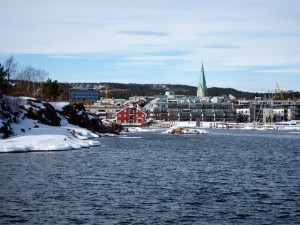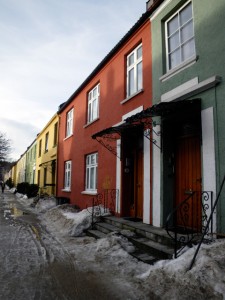So far, I’ve been in Norway for a month, and I’ve managed to visit all the major cities, and some of the minor ones, in the southern coastal region. Kristiansand, Stavanger, and Bergen have been my most recent ports-of-call, and I did some exploring and I did some dawdling, and I like to think I picked up on the atmosphere in each town. They’re all different and unique, but more similar to each other than perhaps their residents realize.
Kristiansand is the port where many of the ferries from Denmark dock, and is apparently Norway’s Number 1 holiday resort. Apparently, it has nice beaches, and is the place where Norwegians take their summer vacations. Personally, I didn’t find it that interesting, although spring, with its slowly melting snow, can make a lot of places feel that way.
It’s the place my great-grandparents emigrated from, so I wanted to see it from a historical perspective; I wondered what it might have looked like and what they might have seen before they left. I was disappointed for them that this was their last glimpse of Norway, although I can’t be sure what they actually saw. What I saw was an industrial port city, with containers stacked 4 and 5 high, cranes and conveyor belts for loading and unloading, and a glass-enclosed skyway snaking over it all leading to the passenger ferries to Denmark. Slush and dirty snow still covered the sidewalks and the main street was choked with rush hour traffic.
It wasn’t all bad, though. The sun was shining, the temperature was warm, and everyone was out on the streets, enjoying the fine spring day. Once I got away from the port, the pedestrian streets were lively and interesting. The shops ran the gamut from boring chain stores to vintage boutiques to art galleries. The walking paths around the Odderøya Peninsula, though still covered with snow, revealed the town’s natural beauty amid the pine trees and hills.
Stavanger had very little snow left, but did snow while I was there—while the sky was blue, no less. I stayed at a B&B that must be the local showroom for IKEA, from the stark lines and classic Scandinavian minimalism that filled every room. They didn’t skimp on the winter amenities, however, and the fluffy down comforter on my bed proved useful on that one snowy morning.
I took a boat tour into the Lysefjord, east from Stavanger. The tours are drastically curtailed during winter, so I didn’t get to see the whole fjord, but it was spectacular enough. The landscape in the Stavanger area is different than the rest of coastal Norway, with rounded hills of barren rock, stunted shrubs and bushes growing in tufts in the cracks and crevices. I saw the famous Preikestolen—or Pulpit Rock, named for its shape—from the bottom, of course, and promised myself someday I’d come back in the summer and see it from the top. It’s a 600m cliff face with a flat top that juts straight up out of the fjord, disconnected from the main body of rock that surrounds it. The captain assured us, multiple times, that it was in no danger of falling into the fjord.
Gamle Stavanger, or Old Stavanger, was the most interesting part of the city. The houses exist just as they did at the turn of the 20th century, so it’s possible to get an idea of how people might have lived a century ago. Narrow cobblestone lanes separated rows of small, multi-storied clapboard houses with sharply peaked roofs. Though some have been turned into artists’ studios or workshops, others are still family homes, complete with tiny terraced gardens and spectacular fjord views.
I am now in Bergen, Norway’s second-largest city, and one of its oldest. It’s been a fishing town for as long as it’s been a town, but for much of the medieval period the trade was controlled by the Hanseatic League. It’s still possible to walk through the Bryggen, the Hanseatic wharf area where the merchants and fisherman once did their trading. The area was destroyed by fire many times throughout the years, but highly specific building regulations meant that the wharf was rebuilt the same way each time. The current buildings date from the 18th century, and are undergoing restoration work, which is supposed to be performed using the tools and materials that would have been used the last time the area was built (though I did see a few workers with power tools—I’m pretty sure they didn’t have those way back then). Honestly, I was glad I got to walk through the area in the off-season; though most of the shops were closed, I could easily imagine the area choked with tourists.
Bergen’s most charming neighborhoods, however, lay on the steep hills behind the wharf area, and beyond the city center. Again, cobblestone lanes and white clapboard townhouses characterized the area, but in Bergen, the landscape is not just hilly, it’s virtually vertical, so the houses are built into hillsides and the lanes slope at dangerous angles. Each house, though it fits in with its surroundings, had to be unique enough to fit into its own section of hillside. And the views, of course, were spectacular.
Except for Trondheim, I have now visited all of Norway’s major cities. While they’re similar—they are all coastal—they all have their own vibe and atmosphere. As I’ve headed north, I’ve liked each town more than the last, so who knows what I’ll find above the Arctic Circle…






{ 2 comments… read them below or add one }
Liked the photos of the streets & buildings in each city – each artfully shot. Nice job. Where are you staying in Bergen – did you make it up to a hostel up one for those vertical streets? One request…. could the writer post one photo in each blog addition with a photo of herself in the scenery? We miss you and seeing you in the mix would help. Only a suggestion. Are you finding the people to be some of the most fit populas you have seen on your travels?
Dear Britta,
My heartfelt condolences to you and your family on the passing of your dear grandmother. If ever a life should be acknowledged for its legacy of love, loyalty, and devotion, it is your grandmother’s, and truly her heart lives on in you. The gift you gave her – of your extended presence and all manner of physical and psychic comfort – at the time of your talented and vivacious youth, when the world was yours, will always be remembered, as it also offered relief and reassurance to the rest of the family. I think of you as a free Soul, and so it’s no coincidence then that you were in Norway at the time of your grandmother’s passing – you journeying back and her forward, both of you arriving anew at the beginning of your roots. May God bless both of your sojourns. With love, Donna